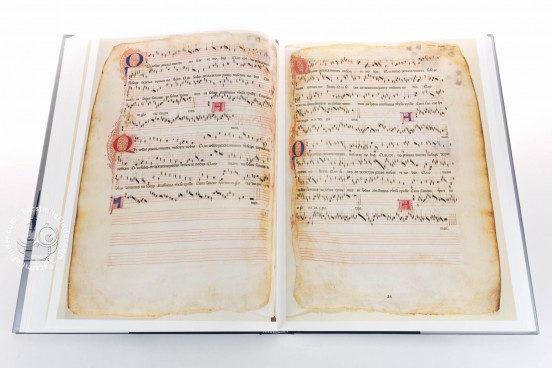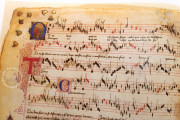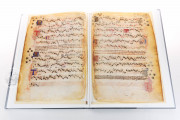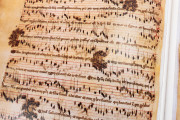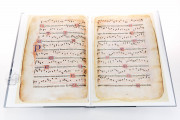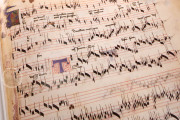The Cypriot-French Manuscript of Polyphony is a large book of Christian plainchant and sacred and secular polyphonic vocal music, probably copied around 1413-1420, with a cycle of Mass ordinary chants added after 1420. Although its place of origin is uncertain, it was probably copied at the court of Janus, King of Cyprus and Armenia, at Nicosia. Although fire damaged the margins of its pages in 1904, the manuscript is preserved in its entirety, including its decoration of two historiated initials, one with a full border, and hundreds of painted and pen-flourished initials.
Almost all of the manuscript's repertoire is preserved uniquely and anonymously in this source. One French ballade, Fuyés de moy, is attributed to "Alain," and it is the one piece found in other sources. Included are chants for the Divine Office and Mass for Saint Hilarion (d. 371), a pioneer of Palestinian monastic asceticism, and a comparable set of chants for Saint Anne, mother of the Virgin Mary.
Visual Focus on Saints
Historiated initials open the votive offices, each featuring a representation of the saint: Saint Hilarion on fol. 1r and Saint Anne on fol. 14r. Saint Hilarion is shown as an elderly man with a long grey beard and holding a book. The border of the page has foliate motifs, and the lower border features an angel holding an unidentified coat of arms. The pen-flourished initials of the original repertoire are red with purple flourishing and blue with red flourishing.
Two Kinds of Notation
The melodies of the plainchant are written in square notation (with squarish noteheads) on a five-line staff. The polyphonic pieces are notated in black mensural notation (with noteheads in the shape of slim diamonds) on a five-line staff with coloration (an indication of rhythm) in red.
Sacred and Secular Song
The manuscript's original contents are arranged into five sections separated from each other by one or more blank pages. The first three contain liturgical chant (fols. 1r-28r), polyphonic Mass movements (fols. 29r-57r), and Latin- and French-language motets (fols. 59r-97r). The final two sections are of French-language secular songs in the standard poetic forms of the period: ballades (fols. 98r-139v) and virelais and rondeaux (fols. 143r-158v).
Two Script Styles
As many as five text scribes and two music notators collaborated on the original repertoire. One scribe supervised the others and was responsible for most of the text and musical notation. Yet another scribe was responsible for the added Mass (fols. 139v-141v), which features strapwork initials that are unlike the decoration of the bulk of the book. The masses, offices, and motets are written in Gothic Textualis, the ballades, virelais, and rondeaux in Gothic Cursiva.
Perhaps Made for a Queen
It has been speculated that the manuscript was made for Charlotte of Bourbon (1388-1422), consort of King Janus, and that it was subsequently owned by their daughter Anne of Lusignan (1418-1462), Duchess of Savoy, traveling to Savoy in 1434 as a part of her dowry. The manuscript was in the Biblioteca Universitaria, successor to the ducal library of Savoy, in the mid-eighteenth century. The current binding of light brown leather over boards with metal clasps dates from the twentieth century. The parchment pages are now mounted on paper guards.
We have 1 facsimile edition of the manuscript "Cypriot-French Manuscript of Polyphony": Il Codice J.II.9 facsimile edition, published by Libreria Musicale Italiana, 1999
Request Info / Price
